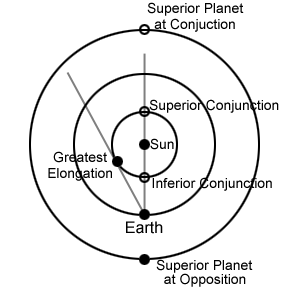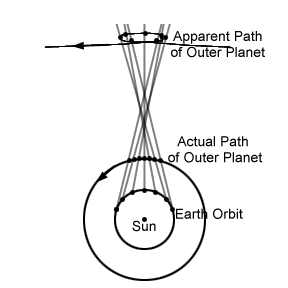| Physics 320 |
Astrophysics I: Lecture #2
|
Prof. Dale E. Gary
NJIT
|
The View of the Solar System from
Earth:
Positions in the Sky
A: History of Solar
System Models
1. The Ptolemaic System
The ancient model
for the solar system is called the Ptolemaic
system, because it was written down by Claudius Ptolemy
(c. 100 AD) in his 13-book work, the Almagest, although it is an
"obvious" model that originated in prehistory. Also called the Earth-centered,
or geocentric, system, it placed the immovable Earth at the center, with
the Sun and planets going around it (attached to heavenly spheres).
Handed down from Aristotle (384-322 BC) was the notion that all motions
having to do with the heavens had to be perfect, hence circular. Hipparchus (c. 150 BC) proposed a system of circles to explain the odd motions of the planets as seen from Earth.
Careful
observations of the sky over many years show that planets obey certain
rules. They align with the Sun (conjunctions),
where they often become faintest, and they appear opposite the Sun (opposition),
where they become brightest. Near opposition, planets sometimes
stop, reverse direction (retrograde motion),
then move forward again. Two of the planets,
Mercury and Venus, never wander very far from the Sun, and so reach a maximum
angular distance, called greatest elongation.
These motions can be demonstrated in any planetarium program (e.g. stellarium).
The model of Aristotle, with
planets moving in perfect circles around the Earth, could not account for
these real planetary motions. To explain such things as retrograde
motion and the fact that planets vary in brightness, Ptolemy introduced
three "cheats:"
the eccentric
the epicycle
the equant.
Together,
these adjustments, always involving perfect circles, could be adjusted
to fit almost any situation within the accuracy of observations of his
day (and for another 1500 years!).
2.
The Heliocentric (Copernican)
Model
Although
suggested much earlier, the heliocentric model is attributed to Nicholas
Copernicus who wrote the first "modern" description in his book, De
Revolutionibus in 1543. In this world-view, the Earth moves
in a perfect circle about the Sun (the influence of Aristotle's perfect heavens idea), as do all of the other planets except
the Moon (which was considered a planet), and the rotation of the stars
and planets once every 24-hours was simply accounted for by the turning
of the Earth on its axis. Although this view is far simpler, and
accounts more naturally for the motions of the heavens, it had three problems:
-
A moving
Earth did not agree with everyday experience.
-
A moving
Earth took it from its exalted place at the center of the universe.
-
Although
it could account for retrograde motion and the changing brightness of the
planets, the planetary motions in perfect circles did not give better accuracy
in planet positions than did the Ptolemaic system with epicycles.
[In De Revolutionibus, the Copernican model was justified as an
alternative for calculation of planetary positions.]
We will see in a later lecture
how the accuracy of the Copernican model could be improved, but first,
let us examine the motions of the planets in the sky, and how they are
accounted for by the geometry of the heliocentric model (Figures 1 and
2, below).
 |
 |
| Figure 1: Geometry
of planetary positions, showing greatest elongation, superior conjunction,
and inferior conjunction, for inferior (inner) planets, and conjuction
and opposition for superior (outer) planets. |
Figure 2:
Geometry of planetary motions, showing how retrograde motion arises
from the orbital motions of Earth and a superior (outer) planet. |
Figure 1 above shows why
the inferior planets never wander too far from the Sun, but rather reach
greatest
elongation and then appear to move back toward the Sun. They
have both an inferior conjuction, when the planet lines up with
the Sun on the near side, relative to Earth, and a superior conjuction,
when the planet lines up on the opposite side of its orbit. Figure
1 also shows how a superior planet reaches conjunction only once
(this is a superior conjunction, actually), but when nearest the Earth
is at opposition. Figure 2 shows how retrograde motion
for a superior planet occurs.
Copernicus derived a relationship
between the synodic period, S,
of a planet, and its sidereal period,
P,
defined as follows:
| Synodic
Period: |
Time for a planet to appear
in the same place in the sky relative to the stars (in the same constellation).
This is as seen from Earth, and involves the motion of the Earth. |
| Sidereal
Period: |
Time for a planet to go
once around the Sun (with respect to the stars). This period is independent
of where we are, and does not depend on the motion of the Earth. |
Note that when we talk about
orbital periods in this course, we will always mean sidereal period.
If you wish, you can keep these straight by the following mnemonic: as
we pass by a planet, we "nod" at the synodic
period. The sidereal period, on the
other hand, is the "real" period.
Consider one trip of a planet
around the Sun as traversing 360o.
Then the rate in degrees/year is just 360o/P.
where P is the sidereal period in Earth years. Let's call the Earth's
sidereal period PEarth = E.
What is the value of E? Since the Earth orbits in exactly 1 Earth year (by definition), E
= 1. The rate is then 360o/E
for Earth, and 360o/P
for another planet. The synodic period, S, is the number of
Earth years it takes for Earth to "lap" a planet (i.e., for an outer planet, it
could be from opposition to opposition, while for an inner planet it could
be from greatest elongation to greatest elongation).
Superior Planet: Let's
derive an expression for the relationship between S and P
for a superior (outer) planet. The Earth has to go 360o
around, then go another n degrees to make up for the motion of the
planet in one synodic period. The rate for the Earth, though, is
of course constant, so we have
|
360 + n
|
|
360
|
|
360
|
|
n
|
|
360
|
|
|
=
|
|
==>
|
|
+
|
|
=
|
|
(1) |
|
S
|
|
E
|
|
S
|
|
S
|
|
E
|
|
At the same time, the superior
planet has only gone n degrees total distance around its orbit at
its rate of 360/P, so
Substitute this into equation
(1), and we get:
|
360
|
|
360
|
|
360
|
|
1
|
|
1
|
|
1 |
|
|
+
|
|
=
|
|
or
|
|
=
|
|
- |
|
(Superior Planet) |
|
S
|
|
P
|
|
E
|
|
S
|
|
E
|
|
P |
|
|
By a similar argument, we arrive
at a similar expression for an inferior planet:
|
360
|
|
360
|
|
360
|
|
1
|
|
1
|
|
1 |
|
|
+
|
|
=
|
|
or
|
|
=
|
|
- |
|
(Inferior Planet) |
|
S
|
|
E
|
|
P
|
|
S
|
|
P
|
|
E |
|
|
Example: Look up Venus' orbital
(i.e. sidereal) period in Appendix C, table titled "Planetary Orbital and Satellite Data." We find P = 0.6152 yr.
What is Venus' synodic period (with Earth)? Use the expression for an Inferior
planet
1 / S = 1
/ 0.6152 - 1 / 1
= 1.6255 - 1 = 0.6255
(Note: keep 5 significant figures)
Therefore, the synodic period
is
S = 1.599 yr (583.9
days)
D. What we have Learned
Reasonable people, believing
their own senses, would naturally accept the Ptolemaic (sun-centered) model
of the universe. But as more careful measurements were made, the
Ptolemaic model had to be embellished in ways that became more and more
artificial.
A simpler view, but one that
seems to contradict common sense, is that the Earth is just one of the
planets, and revolves around the Sun. In this view the Earth, Sun,
and another planet make alignments called opposition and conjunction.
For inferior (inner) planets we learned about other relationships: greatest
elongation, inferior conjunction, and superior conjunction. For superior
(outer) planets we learned about retrograde motion. We also learned
about sidereal and synodic periods, and the relationship between them.

